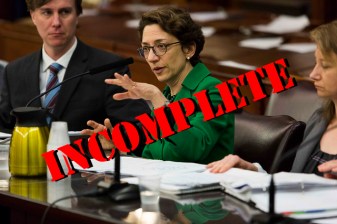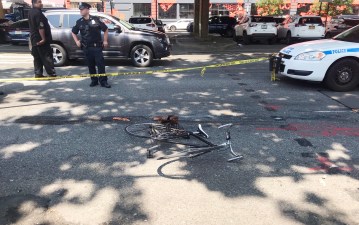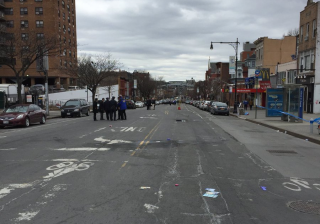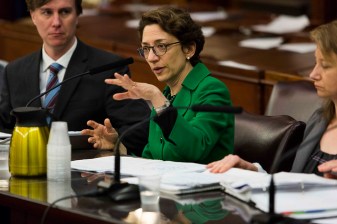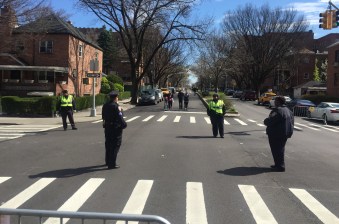DOT’s Forthcoming ‘Cycling Safety Plan’ Won’t Likely Break the Car Culture

Can Polly Trottenberg save Vision Zero?
That’s now the main question after the NYPD announced an underwhelming, creatively challenged, extremely limited three-week ticket-writing blitz as its response to Mayor de Blasio’s demand for action in light of this year’s spate of cyclists’ deaths. Hizzoner had also called on the Department of Transportation to come up with its own plan, so after the NYPD’s announcement, pressure began mounting on DOT Commissioner Trottenberg to make her portion of the mayoral initiative as bold as the NYPD’s was timid.
It’s unclear how bold she’ll be. In a half-hour conversation with Streetsblog, Trottenberg declined to offer specifics about what her “cycling safety plan” would comprise when it is unveiled in about two weeks, but she did say the plan will include:
- New and expanded cycling infrastructure citywide that will further protect cyclists.
- New cycling-oriented policy changes, some of which will be pursued through state or city legislation.
- Increased public awareness and education programs that focus on cyclist safety, including aggressive outreach to truckers and industry partners.
- As announced [Tuesday], enhanced NYPD enforcement; DOT will also work with the NYPD and the state on better truck enforcement.
Streetsblog specifically asked whether Trottenberg’s plan would be bold enough to drive a national conversion on road safety — with such initiatives as car reduction strategies, the creation of pedestrianized zones, a reduction in speed limits or even the conversion of all painted lanes into protected lanes, but Trottenberg wasn’t offering such details.
“I am hoping we will have big and important things in there,” she said, before qualifying, “Most of it involves working with other players. There are a lot of things we would like to do to push the envelope, but we have to work with other agencies.”
Those “other agencies” include recalcitrant bodies such as the state Department of Motor Vehicles, which doles out registrations to 6,000-pound Cadillac Escalade ESVs as easily as it registers the 1,800-pound Smart Fortwo, and does not effectively crack down on recidivist drivers. Trottenberg also has to deal with the car culture of the NYPD and its recklessly driving officers; a city Department of Health that is barely involved in Vision Zero, and a state version that victim-blames pedestrians in its public safety videos; and community boards that often favor car storage over cyclist and pedestrian safety.
Meanwhile, 15 cyclists were killed in the first half of 2019 — five more than in all of 2018. The carnage has prompted Transportation Alternatives to announce a massive “die in” at Washington Square Park on Tuesday, July 9 — an event that is not really Trottenberg’s style, though she admitted that she understood the impulse.
“We are having a very tough year,” she said, heavily.
On July 9, we will mourn, we will remember, and we will make sure that Mayor de Blasio knows that we will not stand for the threat on our lives. pic.twitter.com/OMHe90KlOv
— Transportation Alternatives (@TransAlt) July 2, 2019
In lieu of laying on the cement of Washington Square Park, Trottenberg said she would reach out to advocates and experts over the next two weeks to solicit ideas and innovations that can be quickly implemented to improve road safety. Ideas are not so hard to come up with: Transportation Alternatives offered lots of low-hanging fruit in a 2017 report — easy fixes such as installing more bike parking and expanding bike share to all five boroughs, though the vast majority of which have not yet been tried. And Council Speaker Corey Johnson has a “Let’s Go” plan that calls for dramatic street redesigns, 50 miles of new protected bike lanes per year, more car-free zones, and reducing the size of the city’s own car fleet.
And many activists, plus Queens Council Member Costa Constantinides, have called for the city to scrap its Stipulated Fine Program, which gives delivery and trucking companies the ability to park illegally and unsafely, yet pay only a fraction of the face value of the tickets they receive.
Experts have been emailing Streetsblog all week with their own suggestions, including having DOT take over basic traffic enforcement from an ineffective NYPD, stiffer consequences for city workers who break vehicular or parking laws, basic maintenance of the existing bike network, and getting recidivist scofflaws off the roads entirely. [Streetsblog will be posting a full wish list later this week.]
Here’s the rest of Streetsblog’s interview with Trottenberg, edited for clarity.
Streetsblog: So much of this involves cross-agency cooperation, but I don’t think all agencies share your overall vision for street safety, like DMV…
Polly Trottenberg: There was a period for a long time when there was no DMV commissioner. I would agree that driver education by the state and what is done privately needs more focus. And that’s traditionally at the state level. One area of focus for us is trucks, which have been involved in many of the recent tragedies. The Police Department is committed to doing more. And we will work more with the trucking industry, not as a substitute for road design, but we have a freight division that interfaces with the trucking industry and the big shippers, such as Anheuser Busch, Coke, Fresh Direct, UPS, Amazon, etc.
And we need the help of the City Council, which is working on the safety concerns about the private carting industry. there are improvements needed there and the council is looking at different bills to see how city does private carting, whether with one company in an exclusive zone, or a few companies. Either model would help make the industry safer and reduce mileage.
Streetsblog: You mentioned that DOT will seek “policy changes” at the state and city level. Such as…
PT: Well, again, I don’t want to get into specifics, but we have testified in support of [Council Member] Carlos Menchaca’s bill [which would allow cyclists to get a jump on cars at traffic lights with leading pedestrian intervals]. But as I said, not everything is up to DOT.
Streetsblog: You also mentioned public awareness, but drivers are constantly talking about how bike lanes “ruin” everything and cause congestion, and that cyclists are the ones who are reckless and out of control. You know the truth. Drivers cause virtually every crash and bike lanes do not cause congestion until one of those drivers double-park and screw everything up. So what do you mean “public awareness”?
PT: I genuinely think safety in numbers — the more people out there cycling, the more it changes the composition of the street. Citi Bike has been a tremendous tool for that. It’s part of why the original “Great Streets” plan for Fourth Avenue didn’t have a protected bike lane, but we added it partly because Citi Bike. And soon, we will be announcing Citi Bike’s expansion plan. My messaging has always been, “Hey New Yorkers, share the road and slow down. We’re not enemies here. We can all get where we have to go.”
Streetsblog: But everything always seems like a battle, especially when it comes to getting car drivers to see the benefit of road redesigns — like the one in Morris Park Avenue, over which you are being sued.
PT: I’ve said this thousands of times in five years, and we sometimes take heat from you all [in the bike advocacy community], we do our best to balance the different needs and to have as little effect on all the road users so the street operates at the same level it did before we put the bike lane in. That’s not always people’s perception, of course. and there is congestion in a growing city, but it’s not because of bike lanes.
Streetsblog: The heat you get from us because of that very impulse to make sure the street “operates at the same level.” Why not close a street — like Bergen Street between Third Avenue and Smith Street in Brooklyn, which is a singular bike route from Park Slope to the Manhattan Bridge? Just close it to cars. Fight that battle.
PT: When we have partners, we can do a lot. On Amsterdam Avenue — this was before your time — we wanted to remove a lane from a congested street for a protected bike lane. We had a pretty honest conversation and the community board saw the benefit. We said that taking out a lane might have an effect on the congestion, but we said it would be safer, and it has been.
Streetsblog: The NYPD has announced its unimaginative three-week ticket blitz. [Trottenberg declined to criticize it.] Can you at least tell us if that blitz will focus on known Vision Zero corridors?
PT: Absolutely. We do look at the corridors and we look at hot spots or places where there are reports of drag racing. And in our plan, we will have more to say about coordinating with NYPD to focus on the trouble spots. And part of what is heartbreaking about this crisis is we are struggling to find a pattern [to the deaths]. We do know that trucks have been involved in a disproportionate number of the fatalities, almost 50 percent. But enforcement is only one part of it. We need to build more protected bike lanes. We know that.
